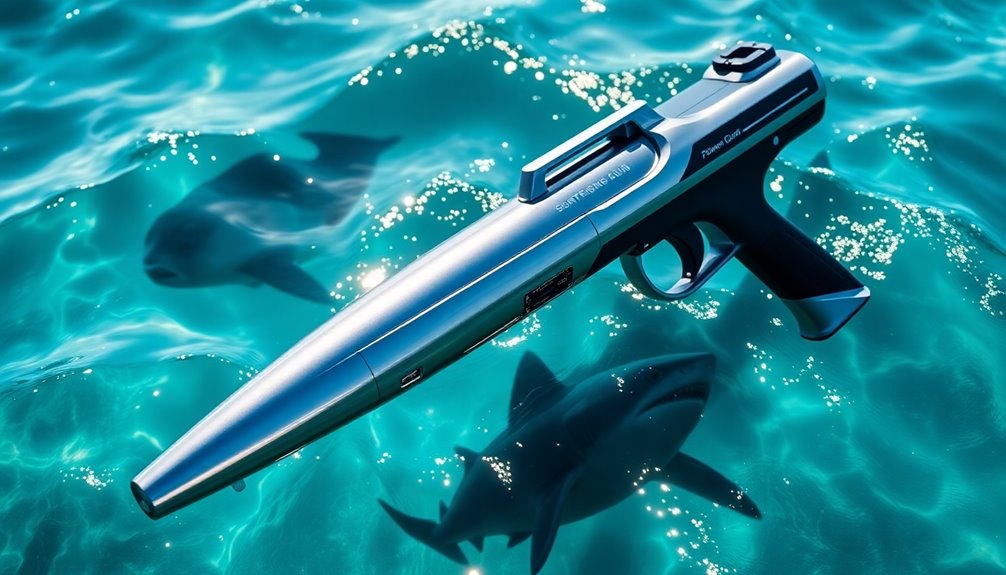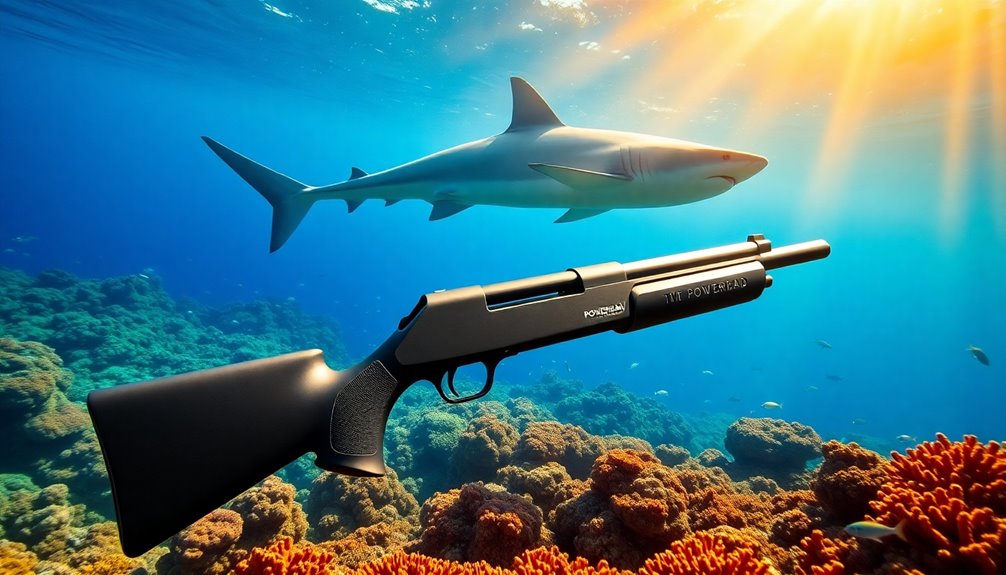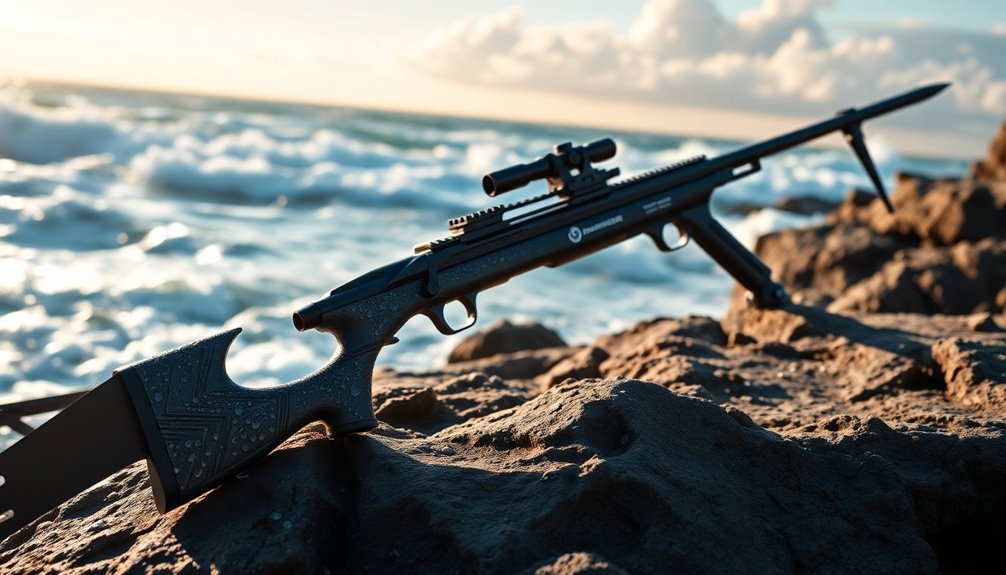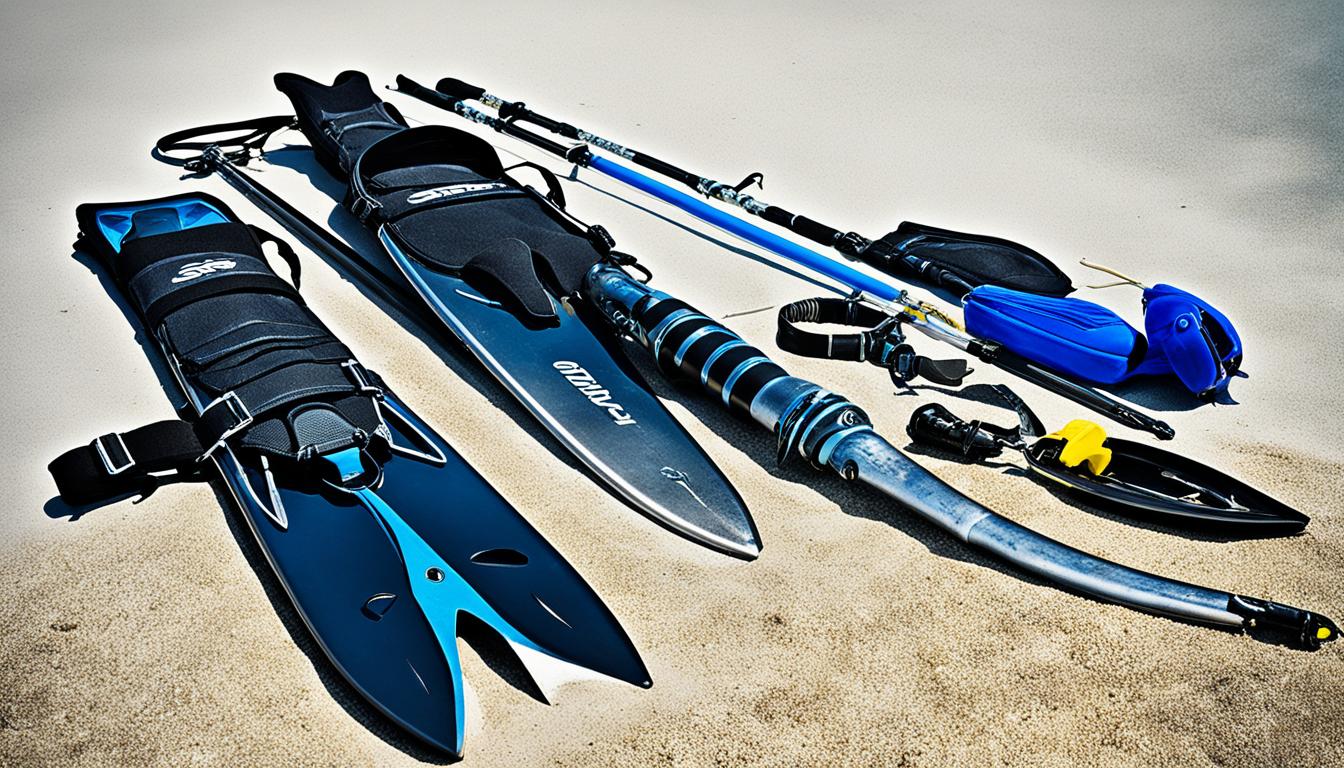The Powerhead shark gun is your go-to solution for underwater safety against sharks. It uses shotgun cartridges to deliver a precise lethal blow, perfect for divers facing larger predators. You can choose between disposable and reusable designs, with the latter offering up to four times the power. With advanced safety features like Perspex hoods and nut-type safety mechanisms, handling is much safer. However, it's important to be aware of local regulations and ethical considerations regarding shark populations. Curious about its innovative technology and how it compares to other options? There's so much more to explore!
Key Takeaways
- Powerheads utilize shotgun cartridges for effective and lethal force against larger shark species, ensuring a powerful response to potential threats.
- Recent advancements improve powerhead design, enhancing safety and reliability during deployment in underwater conditions.
- Reusable powerheads deliver four times the power of disposable models, offering better striking capability for shark defense.
- Safety mechanisms, such as Perspex hoods and nut-type safeties, prevent accidental discharge and enhance user confidence.
- Regulatory compliance is essential, as powerhead usage may be restricted in certain jurisdictions, highlighting the need for awareness before use.
Understanding Powerhead Mechanics

When it comes to understanding powerhead mechanics, it's essential to grasp how these underwater defense tools operate. Power heads utilize shotgun cartridges, delivering lethal force upon contact, making them effective against larger shark species. The key to their operation lies in the explosive charges or projectiles, which require precise handling and deployment to guarantee maximum effectiveness in the heat of the moment.
You'll find power heads in various designs, including disposable and reusable types. Reusable models offer about four times the power of disposable ones, making them a more efficient choice for serious divers.
Safety is paramount, so many power heads integrate features like Perspex hoods and nut-type safety mechanisms to prevent accidental discharge, minimizing user injury.
One important aspect you should never overlook is the proper sealing of ammunition. Using materials like nail polish to seal cartridges is vital for maintaining reliability and performance in underwater environments.
Confirming that your power heads are in ideal condition can make all the difference when facing underwater threats. Understanding these mechanics not only enhances your safety but also boosts your confidence while diving.
The Evolution of Powerheads

As you explore the evolution of powerheads, you'll notice how historical design improvements transformed them from unreliable tools into dependable devices.
Modern safety enhancements reflect a growing awareness of responsible use in shark encounters. Understanding these changes helps you appreciate the balance between protection and conservation.
Historical Design Improvements
Evolving since the 1950s, powerheads have undergone significant design improvements that address early shortcomings like cartridge leaks and misfires. Manufacturers like Sea Hornet spearheaded historical advancements, introducing safety mechanisms such as Perspex hoods and nut-type safety features. These enhancements minimized the risk of accidental discharge, making the devices safer for users and the environment.
By the 1970s, powerheads became more sophisticated with innovations like reusable models, which offered greater striking power and longevity compared to disposable versions. This shift not only improved reliability but also catered to a growing awareness of environmental concerns.
Regulatory changes in various regions have since rendered many older powerhead designs illegal, showcasing a movement towards more cautious and ethical approaches to shark encounters. The emphasis has shifted from lethal methods to non-lethal alternatives, reflecting a commitment to conservation and responsible interactions with marine life.
With these historical advancements, powerheads have transformed, becoming more effective tools that prioritize safety and sustainability. As you explore powerhead options today, you'll notice how far they've come and how they continue to evolve in response to both user needs and ecological considerations.
Modern Safety Enhancements
Modern powerheads have seen a remarkable evolution in safety enhancements, making them more user-friendly and effective for underwater encounters. One of the big advancements includes the incorporation of Perspex hoods, which protect your hands from injuries while handling the device. Additionally, nut-type safety mechanisms help prevent accidental discharge, giving you peace of mind when you're in the water.
The reliability of modern powerheads has improved greatly, addressing historical issues like cartridge leaks and duds. This evolution guarantees that when you pull the firing pin, you can trust the device to perform as intended.
With proper care, current models of reusable powerheads can last indefinitely, showcasing their durability compared to disposable options. To maintain effectiveness, cleaning and sealing your ammunition with nail polish has become essential, making sure that everything works smoothly when you need it most.
Furthermore, regulatory changes have encouraged the development of non-lethal shark deterrent technologies, reflecting a shift towards safer and more environmentally conscious practices during shark encounters. These enhancements not only boost safety but also enhance your confidence while maneuvering underwater environments.
How to Use Powerheads Safely

Using powerheads safely is vital for both your safety and the safety of those around you. First, always verify your powerheads are unloaded and pointed in a safe direction when not in use. This simple step helps prevent accidental discharge.
Familiarize yourself with local regulations regarding powerhead usage, as they might be illegal in certain areas due to safety concerns.
Regular maintenance is important. Clean your powerhead after each use and make sure that the ammunition is properly sealed with nail polish or wax to prevent water damage.
When it's time to use your powerhead, practice precise handling techniques. Aim for close-range deployment to guarantee effective penetration while minimizing risks during underwater encounters.
Lastly, always be aware of your surroundings. Identify your target clearly before firing to avoid unintended injuries or damage.
Ethical Implications of Powerheads

Considering the ethical implications of powerheads reveals a complex interplay between human activities and marine conservation. When you use powerheads in spearfishing, you contribute to a broader debate about their impact on already threatened shark populations. Many species face risks from overfishing and habitat loss, making the use of lethal tools like powerheads especially contentious.
Recent bans in various regions highlight a growing movement towards conservation, emphasizing the significance of non-lethal shark deterrent methods. Advocates for ethical spearfishing argue that employing powerheads undermines efforts to coexist with marine life. This approach can foster negative perceptions of sharks, creatures that play crucial roles in ocean ecosystems.
Additionally, the ethical debate centers on animal welfare; sharks are sentient beings capable of experiencing pain, raising questions about the morality of using lethal force against them. Instead of resorting to powerheads, conservation efforts encourage education on shark behavior and the development of non-lethal deterrent technologies.
Community Views on Powerheads

When it comes to powerheads, your views might clash with those of other divers in the community.
Some see them as vital for safety against larger sharks, while others push for ethical hunting practices and non-lethal alternatives.
With regulations changing and discussions heating up, it's important to reflect on the diverse perspectives on this contentious topic.
Safety Concerns and Regulations
Powerheads spark intense debate within the diving and spearfishing communities, primarily due to safety concerns and varying regulations. Many regions deem powerheads illegal, pushing divers to rely on non-lethal shark deterrence methods. This shift stems from historical issues with powerheads, including cartridge leaks and duds, which raised questions about reliability and safety.
In your discussions about powerheads, you'll notice a split among spearfishers. Some prioritize personal safety against larger predators, while others advocate for conservation and non-lethal practices. This divide reflects broader safety concerns within the community.
Modern powerheads have introduced significant safety features, like Perspex hoods and nut-type safety mechanisms, aimed at preventing accidental discharges and enhancing user safety.
However, you must consider the legal classifications and regulations surrounding powerheads. Compliance with ATF guidelines is essential for safe use in aquatic environments. Familiarizing yourself with these laws not only keeps you within legal boundaries but also helps guarantee your safety and that of those around you.
As the debate continues, staying informed about safety concerns and regulations will aid you in making responsible choices while diving or spearfishing.
Ethical Hunting Practices
While many divers seek protection from larger predators, the ethical implications of using powerheads in spearfishing are increasingly under scrutiny.
Many in the diving community argue that powerheads pose significant risks to shark populations, especially when they target large breeding females, whose removal can disrupt entire ecosystems. This has prompted a shift towards advocating for non-lethal deterrents and catch-and-release practices in spearfishing. Furthermore, the use of power heads can also lead to accidental injury or death of unintended species, such as sea turtles or dolphins. In some areas, the use of power heads is strictly regulated or prohibited altogether in order to protect marine wildlife. Despite their intended use in spearfishing, power heads continue to be a controversial topic in the diving community, with many calling for stricter regulations and increased education on their potential impacts.
Regulatory changes reflect this growing concern, with several regions banning the use of powerheads altogether.
Divers are encouraged to educate themselves about shark behavior, fostering a deeper understanding that can help minimize conflict and promote coexistence with these marine creatures.
Emphasizing conservation efforts, many divers are now adopting sustainable fishing practices that respect the delicate balance of underwater ecosystems.
Community Debate and Perspectives
The debate over the use of powerheads in spearfishing has sparked passionate discussions among divers, reflecting a split in the community. Some divers argue that powerheads are essential safety tools against larger shark species, providing a sense of security in unpredictable underwater environments.
Conversely, many advocate for non-lethal methods of shark deterrence, believing that conservation ethics should guide their practices. Online forums showcase a spectrum of opinions, with discussions about the effectiveness of powerheads clashing against evolving attitudes that discourage harming shark populations.
Many in the community emphasize the importance of proper training and understanding shark behavior, suggesting that education can greatly reduce the perceived need for powerheads. Regulations in certain regions have prompted further debate, as some areas restrict or ban powerheads altogether.
This has led to conversations about compliance, safety, and responsible fishing practices. The emergence of alternative shark deterrent technologies, like carbon dioxide darts, signals a community shift towards more humane methods, raising questions about the future of powerheads in spearfishing.
Ultimately, the conversation continues, reflecting a dynamic community grappling with safety, ethics, and conservation.
Innovations in Shark Defense

Enhancing shark defense technologies has become a crucial focus for divers and marine enthusiasts alike. Recent advancements in powerhead design have introduced improved sealing mechanisms and dual safety features, greatly boosting reliability and user safety during encounters with marine predators.
If you're into spear fishing, you'll appreciate the innovations in reusable powerheads, which utilize larger rounds, delivering approximately four times the power of disposable models. This means you can defend yourself more effectively when dealing with potential threats.
Manufacturers are also creating powerheads that integrate seamlessly with spearguns, allowing you to maintain convenience and quick access underwater. The emphasis on proper training and understanding of equipment use has led to new safety protocols, which contribute to safer interactions between divers and sharks.
Additionally, there's a growing trend towards non-lethal alternatives, like CO2-powered devices, which provide responsible shark defense options without causing harm to these magnificent creatures. Educational resources on shark behavior enhance your awareness, ensuring you're better prepared for your underwater adventures.
These innovations reflect a commitment not only to safety but also to the preservation of marine life.
Legal Aspects of Powerheads

Understanding the legal landscape surrounding powerheads is important for anyone using these devices in the water. The legal aspects of powerheads can vary widely, so it's necessary to know your local laws.
In many areas, powerheads are classified as non-regulated firearms by the ATF if they're 26 inches or longer and lack an onboard firing pin. This classification often makes ownership simpler in certain regions.
However, be cautious—many jurisdictions have enacted regulations that ban older powerhead models due to safety concerns and a push for responsible interactions with marine wildlife. Some areas might even require specific permits for using powerheads, particularly when it comes to protecting marine ecosystems.
Since laws differ greatly between states and countries, you should familiarize yourself with the regulations in your area.
Keep in mind that law enforcement may scrutinize the use and transport of powerheads, making it important to stay informed about both state and federal regulations. Ignoring these legal aspects could lead to serious consequences, so make certain you're compliant to enjoy your shark defense experience without any legal headaches.
Comparing Bangsticks and Powerheads

When it comes to underwater defense, bangsticks and powerheads offer distinct features that cater to different needs.
Bangsticks are designed for immediate elimination of aquatic predators, using a striking mechanism that activates a round against a fixed firing pin. They excel in close defense situations against both marine and land predators. However, they're often single-use, disintegrating upon firing, which could be a drawback for frequent divers.
On the other hand, powerheads are integrated into spearguns and utilize shotgun cartridges, delivering greater striking power, especially against larger shark species. They're typically reusable and can last indefinitely with proper care, making them a more economical option over time.
Powerheads also come with safety features like integrated firing pins and safety hoods, minimizing the risk of accidental discharge. In contrast, bangsticks rely on traditional firearm safety practices, requiring you to be more vigilant.
It's also essential to be aware of the legal implications; while bangsticks may be classified as non-regulated firearms, powerheads can face restrictions in various regions due to their lethal potential.
Ultimately, your choice between bangsticks and powerheads will depend on your specific needs and circumstances.
Best Practices for Spearfishing Safety

Spearfishing safety is vital, especially in waters where sharks are present. Maintaining a calm demeanor helps you stay aware and react appropriately to potential encounters.
Before you immerse yourself, familiarize yourself with the safety features of your powerhead, particularly the nut-type safety mechanism designed to prevent accidental discharge during handling.
Always practice proper handling techniques. Keep your powerhead unloaded when not in use, and point it in a safe direction to avoid accidents. It's essential to verify your powerhead is compatible with your speargun and to inspect it regularly for signs of wear or malfunction. This vigilance will help maintain reliability during use.
Ongoing training is key. Educate yourself about shark behavior and best practices for using powerheads to enhance your safety and effectiveness as a spearfisher. Knowing how to react in various situations can make a significant difference.
Finally, always dive with a buddy whenever possible; having someone watch your back can be invaluable. By following these best practices, you'll create a safer spearfishing experience, allowing you to focus on enjoying the thrill of the hunt while staying protected.
Frequently Asked Questions
Are Powerheads Legal?
Are powerheads legal? It really depends on where you live.
In some states and countries, they're classified as non-regulated firearms, while others have strict laws prohibiting their use, especially for activities like spearfishing.
You've got to check your local regulations to guarantee you're compliant.
Remember, some older models may even be illegal now due to changes in conservation laws.
Always stay informed to avoid any legal issues!
Are Powerheads Legal in Florida?
Are powerheads really legal in Florida? Yes, they are, but you need to be aware of specific regulations that vary by region.
The Florida Fish and Wildlife Conservation Commission mandates that any powerhead you use must meet safety standards and be designed for underwater use.
While you can use them for personal safety against sharks, always stay updated on local laws to guarantee you're following conservation practices and not facing unexpected penalties.
What Are the Shark Defense Weapons?
When considering shark defense weapons, you'll find a range of options.
Powerheads are one type, designed to deliver lethal force underwater. Other tools include shark shields, which use electrical fields to deter sharks, and non-lethal deterrents like spray or acoustic devices.
Each method has its pros and cons, so you'll need to evaluate what suits your needs best, especially regarding safety and effectiveness while engaging in activities like spearfishing or diving.
How Does a Speargun Powerhead Work?
A speargun powerhead works by using shotgun cartridges to deliver explosive force underwater.
When you strike your target, the powerhead's firing pin activates the cartridge, causing it to detonate upon impact. This mechanism neutralizes larger threats quickly.
You'll find reusable models offer better durability and performance.
Remember to seal your ammunition properly to avoid leaks, and always check the safety features to prevent accidental discharge before you head underwater.
Conclusion
To summarize, powerheads offer a remarkable solution for those venturing into shark-infested waters, providing a sense of security like no other. By understanding their mechanics and using them responsibly, you can navigate the ocean with confidence. Remember, though, that with great power comes great responsibility. Embrace ethical practices and stay informed about the community's views and legal aspects. After all, you're not just a spearfisher; you're a guardian of the sea, championing safety and respect for marine life.










